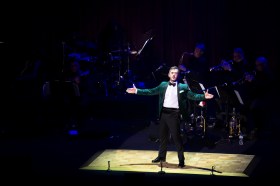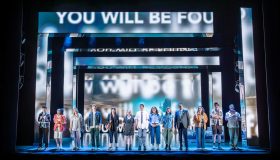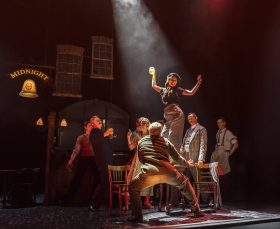If all things are on a spectrum and we dissolve the division between the extremes of diva antics and legitimate self-advocacy, the performing arts sector often sets a very low bar for standards of accessibility for neurodiverse artists outside the realm of the elite.
For an industry that is magnetic to people with unique perspectives and self-expression, it is often very hostile to the sensitivities that artists can have, which, especially for neurodiverse people, are a matter of urgency, not preference. Greater academic understanding and a recent surge in public awareness have both put a spotlight on neurodevelopmental conditions such as autism and ADHD (attention-deficit/hyperactivity disorder) and while we are beginning to see traditional workplaces consider access needs and offer reasonable accommodations, the conventions of performance practice often dictate certain barriers that deserve reconsidering, even outside of strictly disability-led domains.
Read: Autism and the arts
In conversations with three neurodiverse performers, musicians Evelyn Ida Morris and Nat Bartsch, and Tom Middleditch, a theatre-maker and advocacy consultant with the Australian organisatino, Arts Access Victoria, key themes emerge around collective benefit, de-institutionalising ableist standards of value, and the challenges of advocating for invisible disability.
Going deeper, it becomes apparent that the two most critical aspects to address are: helping performing artists identify and better understand their needs, and building a culture within the industry where people of all levels of creative success and access requirements can feel confident they are able to raise their needs and expect a proportionately urgent response to reasonably meeting those needs. It is evident that with due consideration for removing barriers, excellence is no longer a matter of exclusivity, but a standard to which we should all be free to aspire, regardless of ability.
Evelyn Ida Morris is a multi-instrumentalist who has been releasing music since 2007, beginning their career as a musician before having a full awareness of their autism. Morris emphasises burnout as a key challenge centred on unmet needs, but is reassuring in how their diagnosis has been an important step towards sustainable engagement as an artist.
Identifying their neurodivergence has given new perspective to situations where they had previously felt seen as ‘too demanding’, they say. Now realising they were, rather, ‘constantly on the edge of meltdown’, they tell ArtsHub, ‘It would have all been less of a problem if I had known what was going on inside me and what I needed.’
In some ways Morris concedes that being ignorant of their challenges did have some benefits, considering the conditions performing artists can face. ‘If I had started out as a disabled artist it would have been a lot harder,’ they suggest.
Our needs are so different that they’re often contradictory.
Evelyn Ida Morris
This is echoed in Nat Bartsch’s earlier experiences building a career as a pianist and composer before her autism and ADHD diagnosis. She says, ‘None of those neurodiverse needs were met, because I didn’t know I had them.’ This led to burnout and resulted in self-doubt and feeling unsuited to the profession.
Though the demands of life as a performer never truly ease, she feels that having more awareness of her sensory and cognitive needs, along with access to support, allows her to better respond to changing levels of stress and regulation.
Creating an environment where these demands are more manageable would have a critical impact. She says, ‘Part of the solution is to normalise asking for support.’
Presently she feels this is not the case – a sentiment shared by Morris. ‘If it’s not invited, it feels like an imposition,’ says Morris, going on to elucidate the inherent contradiction in expecting autistic people to ‘speak up to people in power and ask for what they need, when we are so often admonished for asking for what we need’.
Read: The case for flexible journalism
Working with artists and venues with his advocacy work with Arts Access Victoria and through experience as an actor, playwright and director, Tom Middleditch offers a considered and detailed account of the kinds of ideals we could pursue. He notes, ‘We have this weird thing where access provisions are considered to be pre-aesthetic. They come in before we consider any of the actual creative work in the space, which is weird because cultural differences are considered to be one of the powerful bedrocks of creative exploration.’
Middleditch makes an argument for the creative potency of embracing the challenges of accessibility needs, which can act as a key generative ingredient, lamenting that ‘artists are robbing themselves of opportunity by not considering the means by which artists are included in their work’.
As the inherent tension between conflicting interests becomes an obvious barrier, Morris is quick to point out: ‘Our needs are so different that they’re often contradictory.’
Speaking more widely with many artists of neurodiverse experience, there are two recurring, oppositional themes that come up consistently, highlighting that there is much to reconcile in considering these isssues. On the one hand, predictability is identified as a core requirement for giving a strong performance, which Bartsch expresses as a desire for a ‘sense of familiarity with the experience before it happens’.
On the other hand, flexibility also rates highly, particularly in relation to time, which seems to be a trigger for many neurodiverse people, as it intersects with challenges around self-regulation, time-blindness and focus. Middleditch says, ‘Expectation is determined by a neurotypical norm.’
On the question of predictability, Bartsch’s experience exemplifies the challenges of a work environment characterised by chaos, where ‘you’re constantly adjusting to so many new conditions’. She highlights how, especially for neurodiverse people, the cognitive load that this demands can be debilitating. Acknowledging how other people are able to more easily take these unknowns in their stride, she empathises with the neurotypical perception that ‘it’s really hard to understand why another person can’t make that pivot’.
We need a diversity of what is considered excellent and to figure out how to decentralise the idea of excellence as the only valuable feedback a piece of art can have.
Tom Middleditch
To reduce the load of rigid expectations placed on performers, she proposes ‘flexibility in terms of the level of engagement you have’ for days when symptoms are flaring, citing double bills as one example where performers are able to share the load.
‘For neurodiverse folks who have performance anxiety, so much of it stems from not having these needs met,’ she says.
To address these issues effectively and make an argument for their value to the wider community, Middleditch says, ‘It requires a different mindset in order to understand what value is in an aesthetic and primarily performance driven economy.’
He is critical of exceptionalism as ‘a system of virtue policing’, in which we value the artistic practice of disabled artists against a different metric, emphasising how the narrative is often about “miraculous” talent in spite of profound challenges. In the current state of affairs, Morris feels greater support is needed, urging us to consider the impact this could have, so that ‘people who are less financially stable would be able to consider contributing their voice more’.
Middleditch is hopeful that if large organisations can ‘lead the way in seeing to the access needs of patrons, workers and artists, those with more difficult needs will start to believe that they have an opportunity to be included as well and thus the circle widens’.
In a typically neurodivergent conversational tangent via Cold War history to illustrate his point, he draws a rather elegant link between politics and aesthetics, inferring that the very framework of excellence confers power inequitably by design.
‘The principles of universal design are such that anything that is considered and targeted for a particular community can eventually be used by everyone,’ he says. ‘We need a diversity of what is considered excellent and to figure out how to decentralise the idea of excellence as the only valuable feedback a piece of art can have.’
Read: Take us as we are – empowering neurodivergent and disabled experiences in the arts
There is no hard line where neurodiversity begins in relation to what is typical, and Bartsch describes the universal nature of human experience in the sense that we all understand states of dysregulation, but stresses that, for neurodiverse individuals, ‘those needs might be greater or more urgent’. She illustrates this well through the self-regulatory nature of “stimming” seen in many neurodiverse people.
‘We’ve all got something we do, like playing with your hair or biting your nails when you’re nervous; everybody’s got some kind of sensory need,’ she explains. Still, while acknowledging the sense of urgency as a key difference for neurodiverse people, it follows that all people would benefit from greater accommodation and accessibility.





